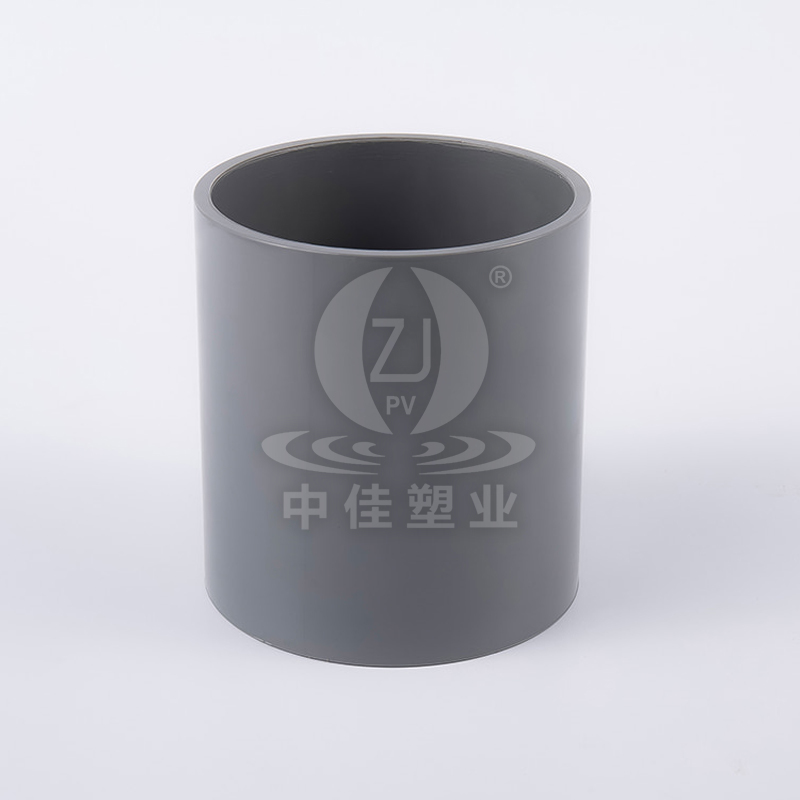

PVC couplings are indispensable connectors in polyvinyl chloride (PVC) pipe systems and are widely used in water supply, drainage, irrigation, and industrial pipes. As an efficient, economical and durable solution, PVC couplings not only simplify the pipe installation process, but also ensure the sealing and stability of the pipe system.
PVC materials themselves have extremely high tolerance to a variety of chemicals such as acids, alkalis, and salts, so PVC couplings are very suitable for corrosive environments such as chemical plants and sewage treatment plants.
Lightweight and easy to install
Compared with metal couplings, PVC couplings are lighter and easier to transport and operate. At the same time, its simple connection method (such as using PVC glue) greatly shortens the construction time.
Good sealing performance
PVC couplings are precisely designed and sealed with special glue or rubber rings to effectively prevent water leakage and ensure the long-term stable operation of the pipe system.
Economical and affordable
PVC couplings have low production costs but excellent performance, making them a very cost-effective pipe connection solution.
Environmentally friendly and recyclable
PVC materials can be recycled and reused, which is in line with the concept of green environmental protection and reduces resource waste.
According to different functions and structures, PVC joints can be divided into the following common types:
Straight Coupling
Used to connect two sections of PVC pipes of the same diameter, it is the most basic and most commonly used type of joint.
Reducer Coupling
Used to connect pipes of different diameters, it plays a transitional role and is often used for flow regulation or pipe branching.
Union Coupling
Union couplings allow pipes to be quickly disassembled and reassembled when needed, especially suitable for occasions with frequent maintenance.
Flange Coupling
Flange couplings are fixed by bolts and are suitable for high-pressure pipe systems or scenarios requiring high-strength connections.
Flexible Coupling
Flexible couplings have built-in rubber sealing rings, which can compensate for the thermal expansion and contraction of pipes to a certain extent, and are suitable for complex terrain or environments with large vibrations.

IV. Application scenarios of PVC joints
Water supply and drainage systems
In household and municipal water supply and drainage systems, PVC joints are widely used to connect water pipes, sewage pipes and rainwater pipes to ensure smooth delivery of fluids.
Agricultural irrigation
In the farm irrigation system, PVC connectors are used to connect sprinkler pipes and drip irrigation pipes, helping farmers achieve efficient and water-saving irrigation.
Industrial pipelines
In industrial fields such as chemical plants, food processing plants and pharmaceutical plants, PVC connectors are ideal for conveying liquids or gases due to their corrosion resistance and hygiene.
Construction
In construction projects, PVC connectors are used to connect drainage pipes, air conditioning condensate pipes and electrical threading pipes, which improves construction efficiency.
Underground pipe network
In underground drainage and cable protection pipe systems, the durability and pressure resistance of PVC connectors make them the preferred connectors.
Easy installation
PVC connectors are easy to operate and can complete efficient pipe connections without complex tools or techniques.
Long service life
High-quality PVC materials give connectors excellent anti-aging properties and can maintain a long service life even in harsh environments.
Wide range of applications
Whether it is home decoration or large-scale engineering projects, PVC connectors can meet diverse needs.
Low maintenance cost
The sealing and corrosion resistance of PVC connectors significantly reduce the frequency and cost of later maintenance.
With the advancement of science and technology and changes in market demand, the PVC connector industry is developing in the following directions:
High-performance materials
Develop new modified PVC materials to further improve the connector's resistance to high temperature, high pressure and impact.
Intelligent monitoring
Integrate sensors into PVC connectors to monitor pipeline pressure, flow and leakage in real time to improve the safety of the system.
Green and environmental protection
More companies will use renewable raw materials to produce PVC connectors and optimize production processes to reduce carbon emissions.
Modular design
Develop multifunctional integrated connectors for different application scenarios to simplify installation processes and improve compatibility.
As an important part of modern pipeline systems, PVC connectors have demonstrated irreplaceable value in various fields with their excellent performance and wide applicability. From water supply and drainage in daily life, to fluid transportation in industrial production, to agricultural irrigation and infrastructure construction, PVC connectors are silently supporting the operation of modern society. In the future, with the continuous emergence of new materials and new technologies, PVC connectors will continue to innovate, provide more efficient and reliable connection solutions for the development of human society, and also contribute to sustainable development.